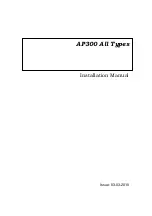
WIT2450
©
2000- 2005 Cirronet
™
Inc
11
M-2450-0000 Rev B
The operation for remotes is similar to the base station without the synchronizing signal.
The amount of data a remote can send on one hop is dependent upon the
hop duration,
the
base slot size
and the number of registered remotes. 212 bytes per hop is the
maximum data length a remote can transmit per hop, subject to limitations imposed by
the
hop duration,
the
base slot
size and the number of registered remotes. A detailed
explanation of this relationship is provided in Section 2.2.3.
Minimum data length
and
data transmit delay
operate the same as with the base station.
Except for the registration process which occurs only when a remote logs onto the
network, the whole procedure is repeated on every frequency hop. Refer to the section
on
Modem Commands
for complete details on parameters affecting the transmission of
data.
2.2. Data Transmission
The WIT2450 supports two network configurations: point-to-point and point-to-
multipoint. In a point-to-point network, one radio is set up as the base station and the
other radio is set up as a remote. In a point-to-multipoint network, a star topology is used
with the radio set up as a base station acting as the central communications point and all
other radios in the network set up as remotes. In this configuration, all communications
take place between the base station and any one of the remotes. Remotes cannot
communicate directly with each other.
2.2.1. Point-to-Point
In point-to-point mode, unless
data transmit delay
or
minimum data length
have been set,
the base station will transmit whatever data is in its buffer limited to 208 bytes or as
limited by the
base slot size
. If the base station has more data than can be sent on one
hop, the remaining data will be sent on subsequent hops. In addition to the data, the base
station adds some information to the transmission over the RF link. It adds the address of
the remote to which it is transmitting, even though in a point-to-point mode there is only
one remote. It also adds a sequence number to identify the transmission to the remote.
This is needed in the case of acknowledging successful transmissions and retransmitting
unsuccessful transmissions. Also added is a 24-bit CRC to allow the base to check the
received transmission for errors. When the remote receives the transmission, it will
acknowledge the transmission if it was received without errors. If no acknowledgment is
received, the base station will retransmit the same data on the next frequency hop.
In point-to-point mode, a remote will transmit whatever data is in its buffer up to the limit
of its
maximum data length.
If desired,
minimum data length
and
data transmit delay
can
also be set, which force the remote to wait until a certain amount of data is available or
the specified delay is exceeded before transmitting. If the remote has more data than can
be sent on one hop, it will send as much data as possible as a packet, adding its own
address, a packet sequence number and 24-bit CRC. These additional bytes are
transparent to the user application if the protocol mode is
00H
(which is the default). In
the event a remote has more data to send, the data will be sent on subsequent hops. If the












































